Standard [CURRENT]
ASTM E 1921:2025
Standard Test Method for Determination of Reference Temperature, T0, for Ferritic Steels in the Transition Range
- Publication date
- 2025
- Original language
- English
- Pages
- 41
- Publication date
- 2025
- Original language
- English
- Pages
- 41
- DOI
- https://dx.doi.org/10.1520/E1921-25
Product information on this site:
Quick delivery via download or delivery service
Buy securely with a credit card or pay upon receipt of invoice
All transactions are encrypted
Short description
1.1 This test method covers the determination of a reference temperature, T 0 , which characterizes the fracture toughness of ferritic steels that experience onset of cleavage cracking at elastic, or elastic-plastic KJc instabilities, or both. The specific types of ferritic steels ( 3.2.5 ) covered are those with yield strengths ranging from 275 MPa to 825 MPa (40 ksi to 120 ksi) and weld metals, after stress-relief annealing, that have 10 % or less strength mismatch relative to that of the base metal. 1.2 Testing under Test Method E1820 is generally required for use of Test Method E1921 with notable exceptions on specific aspects of the testing that need to be more tightly controlled within Test Method E1921 . Those unique provisions are specifically called out in Test Method E1921 . 1.3 The specimens included are fatigue precracked single-edge bend bars, SE(B), and compact tension, C(T), or disk-shaped compact tension, DC(T), specimens as described in Test Method E1820 . 1.4 Median KJc values at a given temperature tend to vary between SE(B) and C(T)/DC(T) specimen types at a given test temperature, presumably due to constraint differences among the allowable test specimens in 1.3 . 1.5 Requirements are set on specimen size ( 7.5 ) and the number of replicate tests ( 10.3 ) that are needed to establish acceptable characterization of KJc data populations. As indicated in 10.3 , a minimum of 6 test specimens is required. 1.6 T 0 is dependent on the K -rate. T 0 is evaluated for a quasi-static loading K -rate range with 0.5 < < 2 MPa√m/s. Slowly loaded specimens ( < 0.5 MPa√m) can be considered valid if environmental effects are known to be negligible. Provision is also made for higher K -rates ( > 2 MPa√m/s) in Annex A1 . Note that this threshold K -rate for application of Annex A1 is a much lower threshold than is required in other fracture toughness test methods such as E399 and E1820 . 1.7 A limit on KJc values, relative to the specimen size, is specified to ensure high constraint conditions along the crack front at fracture. For some materials, particularly those with low strain hardening, this limit may not be sufficient to ensure that a single-parameter ( KJc ) adequately describes the crack-front deformation state ( 1 ) . 2 1.8 The procedures described in this test method assume that the data set represents a macroscopically homogeneous material, such that the test material has uniform tensile and toughness properties. A screening method ( 10.6 ) is provided to determine if the material may be inhomogeneous and methods are provided in Appendix X5 to evaluate such materials. Application of this test method to an inhomogeneous material may result in an inaccurate estimate of the transition reference value T 0 and nonconservative confidence bounds. 1.9 This standard does not purport to address all of the safety concerns, if any, associated with its use. It is the responsibility of the user of this standard to establish appropriate safety, health, and environmental practices and determine the applicability of regulatory limitations prior to use. 1.10 This international standard was developed in accordance with internationally recognized principles on standardization established in the Decision on Principles for the Development of International Standards, Guides and Recommendations issued by the World Trade Organization Technical Barriers to Trade (TBT) Committee.
ICS
77.040.10
DOI
https://dx.doi.org/10.1520/E1921-25
Also available in
Loading recommended items...
Loading recommended items...
Loading recommended items...
Loading recommended items...

